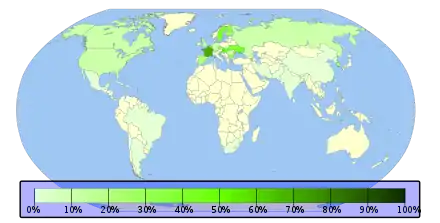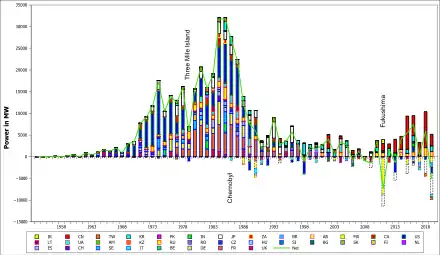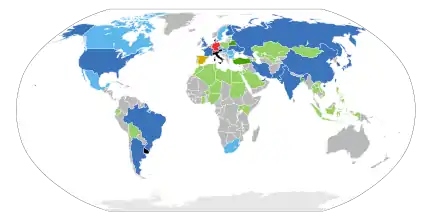Nuclear power by country
Nuclear power plants operate in 32 countries.[1] Most are in Europe, North America, East Asia and South Asia. The United States is the largest producer of nuclear power, while France has the largest share of electricity generated by nuclear power, at about 75%.[2] China has the fastest growing nuclear power programme with 16 new reactors under construction.[3]
Some countries operated nuclear reactors in the past but have no operating nuclear plants. Among them, Italy closed all of its nuclear stations by 1990 and nuclear power has since been discontinued because of the 1987 referendums. Kazakhstan and Armenia are planning to reintroduce nuclear power in the future. Belarus began operating one unit of its first nuclear power plant in June 2021 and expects to bring the second unit into operation in 2022.[4]
Three countries that are currently operating nuclear power plants are planning a nuclear power phase-out. These are Germany, Spain, and Switzerland. Taiwan is considering a phase-out. Austria (Zwentendorf Nuclear Power Plant) and the Philippines (Bataan Nuclear Power Plant) never started to use their first nuclear plants that were completely built.
Sweden and Belgium originally had phase-out policies however they have now moved away from their original plans. The Philippines relaunched their nuclear programme on February 28 2022 and may soon operate the mothballed Bataan Plant.[5][6]
Due to financial, political and technical reasons, Cuba, Libya and Poland never completed the construction of their first nuclear plants, and Australia, Azerbaijan, Georgia, Ghana, Ireland, Kuwait, Oman, Peru and Singapore never built their planned first nuclear plants.[7][8] Some of these countries are still planning to introduce nuclear power. As of 2020, Poland is in advanced planning phase for 1.5 GW and plans to have up to 9 GW by 2040.[9] Hong Kong has no nuclear power plants within its boundary, but imports 80% of the electricity generated from Daya Bay Nuclear Power Station located across the border, in which the power company of the territory holds stake.[10][11] The government had also proposed to increase the share of nuclear energy to 50%.[12] In 2021, Iraq declared it plans to build 8 nuclear reactors by 2030 to supply up to 25% electric power in the grid that suffers from shortages.[13]
Overview



|
Operating reactors, building new reactors Operating reactors, planning new build No reactors, building new reactors No reactors, planning new build |
Operating reactors, stable Operating reactors, considering phase-out Civil nuclear power is illegal No reactors |
Of the 32 countries in which nuclear power plants operate, only France, Slovakia, and Ukraine use them as the source for a majority of the country's electricity supply as of 2020. Other countries have significant amounts of nuclear power generation capacity. By far the largest nuclear electricity producers are the United States with 789,919 GWh of nuclear electricity in 2020, followed by China with 344,748 GWh.[1] As of March 2022, 439 reactors with a net capacity of 392,244 MWe are operational, and 54 reactors with net capacity of 53,905 MWe are under construction. Of the reactors under construction, 16 reactors with 15,984 MWe are in China and 8 reactors with a capacity of 6,194 MWe are in India.[15]
| Country | Reactors | Capacity Net-total (MWe) |
Generated electricity (GWh) |
Share of total electricity use |
Notes | |
|---|---|---|---|---|---|---|
| Operational | U/C | |||||
| 3 | 1 | 1,641 | 10,012 | 7.5% | ||
| 1 | 0 | 415 | 2,552 | 34.5% | ||
| 0 | 2 | N/A | N/A | N/A | ||
| 1 | 1 | 1,110 | 338 | 1.0% | ||
| 7 | 0 | 5,942 | 32,793 | 39.1% | Phase-out postponed | |
| 2 | 1 | 1,884 | 13,244 | 2.1% | ||
| 2 | 0 | 2,006 | 15,938 | 40.8% | ||
| 19 | 0 | 13,624 | 92,166 | 14.6% | ||
| 53 | 16 | 50,789 | 344,748 | 4.9% | ||
| 1[lower-greek 1] | 0 | 688 | 6,041 | 37.8% | ||
| 6 | 0 | 3,934 | 28,372 | 37.3% | ||
| 5 | 0 | 4,394 | 22,354 | 33.9% | ||
| 56 | 1 | 61,370 | 338,671 | 70.6% | ||
| 3 | 0 | 4,055 | 60,918 | 11.3% | 2022 Phase-out | |
| 0[lower-greek 2] | 0 | N/A | N/A | 28%[16][17][18] | ||
| 4 | 0 | 1,902 | 15,179 | 48.0% | ||
| 23 | 8 | 6,885 | 43,029 | 3.1% | ||
| 1 | 1 | 915 | 5,792 | 1.7% | ||
| 33 | 2 | 31,679 | 43,099 | 5.1% | Many reactors stopped | |
| 24 | 4 | 23,150 | 152,583 | 29.6% | ||
| 2 | 0 | 1,552 | 10,864 | 4.9% | ||
| 1 | 0 | 482 | 3,886 | 3.2% | ||
| 6 | 0 | 3,256 | 1,330 | 8.0% | ||
| 2 | 0 | 1,300 | 10,575 | 19.9% | ||
| 37 | 4 | 28,578 | 201,821 | 20.6% | ||
| 4 | 2 | 1,837 | 14,357 | 53.1% | ||
| 1[lower-greek 1] | 0 | 688 | 6,041 | 37.8% | ||
| 2 | 0 | 1,860 | 11,616 | 5.9% | ||
| 7 | 0 | 7,121 | 55,825 | 22.2% | Phase-out planned | |
| 6 | 0 | 6,882 | 47,362 | 29.8% | ||
| 4 | 0 | 2,960 | 23,049 | 32.9% | Gradual Phase-out planned | |
| 3 | 0 | 2,859 | 30,342 | 12.7% | Phase-out planned | |
| 0 | 3 | N/A | N/A | N/A | ||
| 15 | 2 | 13,107 | 71,550 | 51.2% | ||
| 2 | 2 | 2,690 | 1,560 | 1.1% | ||
| 11 | 2 | 6,848 | 45,668 | 14.5% | ||
| 93 | 2 | 95,523 | 789,919 | 19.7% | ||
| World total | 439 | 54 | 392,244 | 2,553,200 | ||
See also
Notes
- One reactor located within Slovenia, co-owned by and shared between Croatia and Slovenia.
- Two reactors located outside the territory, in which a power company of the territory holds stake, and which exports 80% of the electricity it generates to the territory.
References
- "Plans for new reactors worldwide". World Nuclear Association. Retrieved 21 April 2022.
- "Nuclear Power in France | French Nuclear Energy - World Nuclear Association". www.world-nuclear.org. Retrieved 8 January 2021.
- "China Nuclear Power | Chinese Nuclear Energy - World Nuclear Association". www.world-nuclear.org.
- International Atomic Energy Agency. Country Nuclear Power Profiles: Belarus (updated 2021).
- "Philippines relaunches nuclear energy programme : Nuclear Policies - World Nuclear News".
- "Sweden Reverses Nuclear Phase-out Policy".
- Duroyan Fertl (5 June 2011). "Germany: Nuclear power to be phased out by 2022". Green Left.
- James Kanter (25 May 2011). "Switzerland Decides on Nuclear Phase-Out". New York Times.
- Wilczek, Maria (16 June 2020). "Construction of Poland's first nuclear power plant to begin in 2026". Notes From Poland. Retrieved 18 June 2020.
- "Hong Kong fallout from China's reckless nuclear ambitions".
- "CLP to increase nuclear power imports 10pc".
- http://aesc.hkbu.edu.hk/wp-content/uploads/2014/10/AESC_Working_Paper_11.pdf?q=7K_1CkiZuB0J#page=10
- "Iraq hopes to build 8 nuclear power reactors by 2030". Brecorder. 15 June 2021. Retrieved 18 June 2021.
- "Operational & Long-Term Shutdown Reactors". IAEA. 13 April 2013. Retrieved 14 April 2013.
- Nuclear Power Reactors in the World (PDF). Vienna: International Atomic Energy Agency. 2020. ISBN 978-92-0-114820-9.
- "Energy Supplies | Environment Bureau".
- http://www.emsd.gov.hk/filemanager/en/content_762/HKEEUD2019.pdf
- "Renewable Energy Landscape in Hong Kong: Utilising the City's Potential". 18 March 2021.